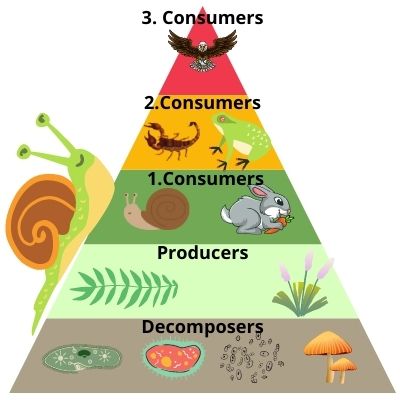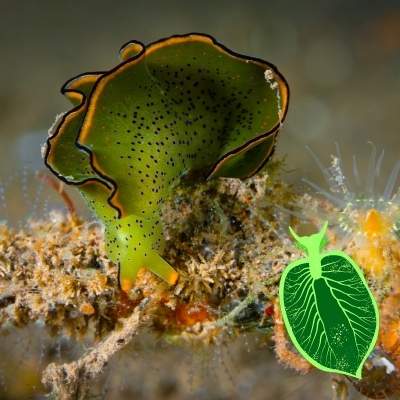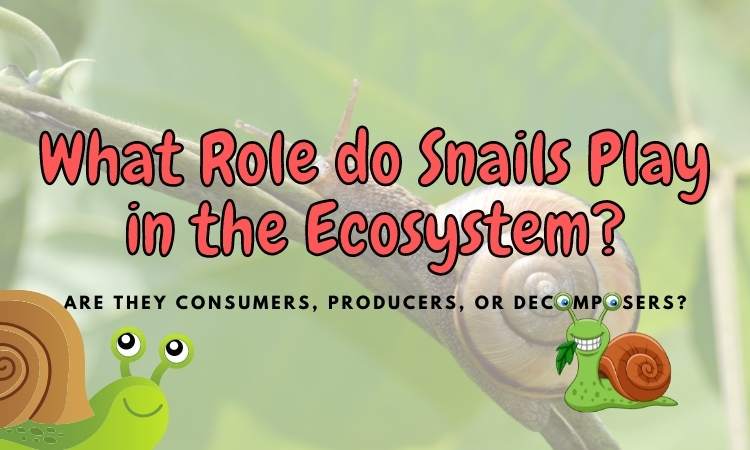Snails may not be considered charismatic organisms, but they play a crucial role in the ecosystem. As it turns out, snails have so much to offer in the interrelated relationship of organisms in the food web that might be visible from their humble appearance.
As such, what is the role played by these organisms in the ecosystem? Are they categorized as decomposers or consumers?
The answer to this question is not as straightforward as you might think, as the different species of snails exist in different environments, and their food sources vary.
Generally, snails are categorized as primary consumers. Consumer organisms are heterotrophs, meaning that they have to acquire their food from other organisms; in this case, mostly living plants. However, snails do, to a lesser extent, also act as decomposers and, interestingly, their sea slug cousins may even act as producers!
Most snails are primary consumers or herbivores, but many are omnivores and eat anything that is accessible to them. This means that most of them consume plants, but some snails can also be considered secondary consumers or carnivores because they also feed off other animals.
True enough, whichever is the role of snails in the ecosystem – consumers or producers – these organisms are involved at every step to complete the cycle of the food chain.
What type of consumer is a snail?
Most snails are primary consumers or herbivores. These species of snails consume plants, herbs, and shrubs where they can adapt to any given situation.
Generally, snails play a critical role for consumers in the ecosystem. Snails can either be categorized as primary or secondary consumers.
More than this, there are snails who consume other animals which classify them as carnivores or secondary consumers.

Most of these carnivorous snail species feed off nematodes and other snails as well. As such, snails can either be primary or secondary consumers but still they themselves serve as prey to larger and more dangerous predators in the food web or food chain.
Are snails also considered decomposers?
Snails also fit the role of decomposers, as they eat decomposing matter like dead leaves and rotting animals.
Snails help break down natural and organic material into smaller parts. Let us take for example land snails that can be found everywhere in Eastern North America.
Take note that the term “land snails” includes snails and slugs generally which possess no exterior shell.
These terrestrial mollusks are known to feed off dead wood, leaves, and various plant parts as well as other varieties of organic material such as algae and fungi. This kind of food consumption lets the snails identify themselves with the lowest trophic level in the energy pyramid.
When does a snail function as a decomposer?
Snails are considered decomposers or detritivores when they feed off dead carcasses of other animals or dying plants and trees with their rotten bark or trunk.
One of the crucial roles of decomposers in the ecosystem is that these organisms break down dead organisms or herbaceous plants and feed off them.
After eating the dead material, the nutrients taken from those dead organisms are returned to the soil which can then be used by producers or autotrophs in making or producing food.
To put into perspective: whereas most of the total decaying organic matter on earth is consumed by bacteria and fungi, snails consume a fairly small part which is likely on par with worms, beetles, and other larger insects.
Are snails scavengers?
Scientifically, there are two types of animal decomposers: detritivores and scavengers. Essentially, snails lean more to the role of being detritivores, as they do not actively seek out dead plants or animals.
Scavengers display different a behavior when it comes to feeding off an organic matter in the environment. Scavengers hunt more actively for the dead materials that they consume, rather than just eating what they pass by – dead or alive – as snails do.
Notable animals that are classified as scavengers are vultures, crabs, crayfish, and hyenas. These animals are notorious to hunt and eat the flesh of dead animals they can get their claws with.
Conversely, snails do not exhibit this hunting behavior just like those scavengers. Essentially, snails are therefore omnivores that scavenge rather than dedicated scavengers.
They help break down organic material found in the environment where the nutrients aid producers in creating food for consumers. Some examples of decomposers are bacteria and fungi.
Simply, snails’ decomposing puts them in the role of a member in the cleanup crew of the ecosystem.
Could a snail be a producer?
Essentially, snails are not considered producers, as they do not produce their own food. Snails take the role of consumers or decomposers in the interconnected relationship of organisms in the food chain or web.
However, snails’ cousins, the slugs, can become producers!
Snails and slugs are similar organisms. However, the obvious difference lies in the fact that snails contain shells while slugs do not possess these shells. Both of these organisms belong to the group of soft-bodied organisms categorized under mollusks.
Have you heard of the species of sea slugs called Elysia cholorotica that is green like algae? This is in fact because they contain algae DNA in their cells!
As it turns out, this sea slug is categorized as a producer! Scientifically, this is the first member of the animal kingdom that is notable for its ability to produce chlorophyll which in turn, is the pigment needed during the process of photosynthesis; effectively making it an autotroph.
There are a few other animals able to exploit algae to produce energy from the sun, but none like the Elysia cholorotica snail making photosynthesis on its own!

As such, snails could in theory take the role of producers just like one of their cousins, the Elysia sea slug, has already done.
Conclusion
In conclusion, snails play a vital role in the ecosystem as decomposers. While they may not be the first organisms that come to mind when we think of decomposition, their actions are crucial in breaking down organic matter and returning nutrients back to the soil.
Snails are efficient consumers of decaying plant material and help accelerate the decomposition process. Their feeding habits, aided by specialized mouthparts and digestive systems, allow them to break down dead leaves, fruits, and other organic debris.
As they consume this organic matter, they facilitate the release of nutrients and make them available for uptake by other organisms. Furthermore, snails also contribute to the overall health of the soil by increasing its aeration and moisture retention through their burrowing activities.
Although snails may be small and seemingly insignificant, they play an important role in maintaining the balance and productivity of ecosystems.
Their decomposer function helps to recycle nutrients and sustain the intricate web of life. By recognizing the value of these often-overlooked creatures, we can develop a greater appreciation for the diverse roles that organisms play in the natural world.
So the next time you spot a snail, remember that it is not just a humble gastropod, but also a diligent decomposer working behind the scenes to keep our ecosystems functioning harmoniously.




